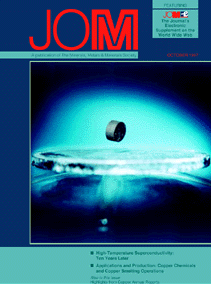
 JOM-e is a periodically presented all-electronic supplement to the conventional print version of JOM-e. Enhanced through the application of hyperlinks and/or other hypermedia features, the papers presented in JOM-e do not appear in print and are available only through TMS OnLine at the addresses shown below. The papers are, however, fully considered to be as much a part of JOM-e as the articles that appear in print. Beginning with the 1998 volume year, JOM-e will be published quarterly.
JOM-e is a periodically presented all-electronic supplement to the conventional print version of JOM-e. Enhanced through the application of hyperlinks and/or other hypermedia features, the papers presented in JOM-e do not appear in print and are available only through TMS OnLine at the addresses shown below. The papers are, however, fully considered to be as much a part of JOM-e as the articles that appear in print. Beginning with the 1998 volume year, JOM-e will be published quarterly.
Research Summary:
The Thermocyclic Behavior of Differently Stabilized and Structured EB-PVD TBCs
U. Schulz, K. Fritscher, C. Leyens, M. Peters, and W.A. Kaysser
Thermal-barrier coatings are increasingly applied to hot components in gas turbines; the most prominent application processes are plasma spraying and electron-beam physical vapor deposition. Electron-beam physical vapor deposition provides distinctive coatings of a unique columnar microstructure. The main advantage of this structure is its superior tolerance against straining, erosion, and thermoshock, thus giving it a major edge in lifetime. Furthermore, cooling hole closure will be prevented and an aerodynamic design of the blades is maintained. This article outlines the interaction between chemical composition and microstructural evolution of zirconia-based thermal-barrier coatings and their respective lifetimes in cyclic burner-rig and furnace tests. Customizing the microstructure by adjusting processing parameters is emphasized. A structural-zone diagram is modified by interconnecting the influence of substrate rotation with the microstructural evolutions.
Research Summary:
The Solubility of Silica in Calcium Ferrite Slags
C.M. Acuña and A. Yazawa
In copper smelting processes, lime flux offers several advantages over silica; however, copper concentrates contain levels of silica that may impair the benefits of lime (i.e., formation of dicalcium silicate). To fully utilize the benefits of lime fluxing, the solubility of silica in the final slag must be investigated. The solubility of silica in calcium ferrite slags was investigated under different atmospheric conditions between 1,473-2,573 K.
Overview:
The Structural Conditions for High-Temperature Superconductivity [pp. 12-17]
M. Haller and R.L. Snyder
Overview:
Reviewing Some Current Theories for High-Temperature Superconductors [pp. 18-23,50]
E. Dagotto
Overview:
The Freeway Model: New Concepts in Understanding Supercurrent Transport in Bi-2223 Tapes [pp. 24-27]
G.N. Riley, Jr., A.P. Malozemoff, Q. Li, S. Fleshler, and T.G. Holesinger
Overview:
Progress in the First Ten Years of HTS Film Growth [pp. 28-32]
Douglas B. Chrisey
Overview:
The U.S. Production of Copper Chemicals from Secondary and By-product Sources [pp. 34-37,49]
P.B. Queneau and R.W. Gruber
Overview:
The Production and Application of Cuprous Oxide and Cupric Hydroxide [pp. 38-39]
Adalbert Lossin and Franz-Josef Westhoff
Overview:
Recovering Copper and Copper Chemicals from Spent Alkaline Etchant [p. 40]
T. Kawashima
Industrial Insight:
Making Improvements in Smelting Capacity at Onsan Copper Smelter [pp. 44-46]
Y.C. Kang and S.S. Park
| Search | Tables of Contents | Subscription Information | JOM Home Page | TMS OnLine |
|---|